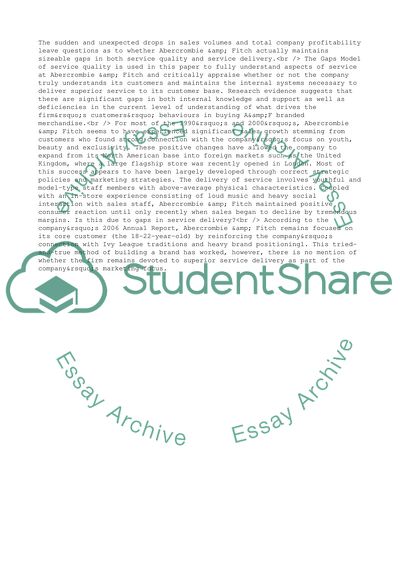Cite this document
(Service Quality of Abercrombie & Fitch Company Case Study, n.d.)
Service Quality of Abercrombie & Fitch Company Case Study. Retrieved from https://studentshare.org/business/1551364-apply-the-gaps-model-of-service-quality-to-a-specific-retail-organisation-and-show-by-analysis-and-critical-evaluation-the-effectiveness-of-its-customer-service-management-and-how-this-might-improved-compile-a-report-of-your-findings
Service Quality of Abercrombie & Fitch Company Case Study. Retrieved from https://studentshare.org/business/1551364-apply-the-gaps-model-of-service-quality-to-a-specific-retail-organisation-and-show-by-analysis-and-critical-evaluation-the-effectiveness-of-its-customer-service-management-and-how-this-might-improved-compile-a-report-of-your-findings
(Service Quality of Abercrombie & Fitch Company Case Study)
Service Quality of Abercrombie & Fitch Company Case Study. https://studentshare.org/business/1551364-apply-the-gaps-model-of-service-quality-to-a-specific-retail-organisation-and-show-by-analysis-and-critical-evaluation-the-effectiveness-of-its-customer-service-management-and-how-this-might-improved-compile-a-report-of-your-findings.
Service Quality of Abercrombie & Fitch Company Case Study. https://studentshare.org/business/1551364-apply-the-gaps-model-of-service-quality-to-a-specific-retail-organisation-and-show-by-analysis-and-critical-evaluation-the-effectiveness-of-its-customer-service-management-and-how-this-might-improved-compile-a-report-of-your-findings.
“Service Quality of Abercrombie & Fitch Company Case Study”, n.d. https://studentshare.org/business/1551364-apply-the-gaps-model-of-service-quality-to-a-specific-retail-organisation-and-show-by-analysis-and-critical-evaluation-the-effectiveness-of-its-customer-service-management-and-how-this-might-improved-compile-a-report-of-your-findings.


